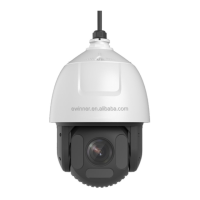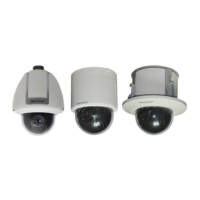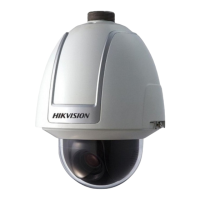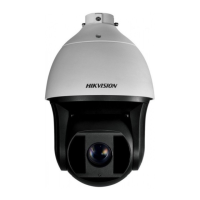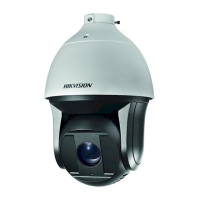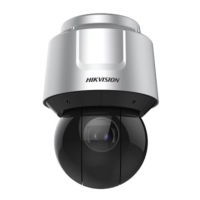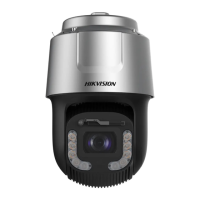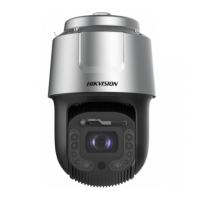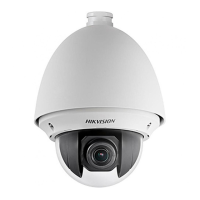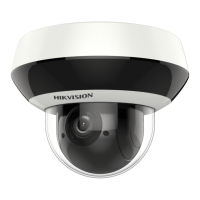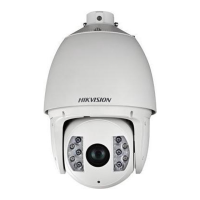
Do you have a question about the HIKVISION DS-2DF7284-AW and is the answer not in the manual?
| Image Sensor | 1/3" Progressive Scan CMOS |
|---|---|
| Effective Pixels | 1280 (H) x 960 (V) |
| Lens | 4.3 - 86.0mm, 20x |
| Zoom | 20x Optical |
| Power Supply | 24 VAC |
| Dimensions | Φ220 × 353.4mm (Φ8.66” × 13.91”) |
| Weight | Approx. 5 kg (11.02lbs) |
| Min. Illumination | Color: 0.05Lux @(F1.4, AGC ON); B/W: 0.005Lux @(F1.4, AGC ON) |
| IR Distance | Up to 100m |
| Number of Preset | 256 |
| Protection Level | IP66 |
| Ingress Protection | IP66 |
| Camera Type | PTZ |
| Minimum Illumination | 0.005 Lux @ (F1.6, AGC ON), 0 Lux with IR |
| Video Compression | H.264/MJPEG |
| Digital Zoom | 16x |
| Pan Range | 360° |
| Operating Temperature | -30°C to 65°C (-22°F to 149°F) |
| Sensor Type | Progressive Scan CMOS |
| Network Interface | RJ45 10M/100M Ethernet interface |
| Operating Conditions | -30°C to 65°C (-22°F to 149°F) |
Details FCC compliance for the device, including limits for digital devices.
Outlines the two conditions for FCC compliance: no harmful interference and acceptance of received interference.
Declares conformity with European standards and directives like Low Voltage and EMC.
Important safety precautions to prevent serious injury or death if neglected.
Precautions to prevent potential injury or material damage if neglected.
Specifies the minimum system requirements for web browser access, including OS, CPU, RAM, and browser versions.
Describes the physical appearance of the speed dome camera with an accompanying image.
Lists and briefly explains the key functions of the speed dome, such as Limit Stops and Scan Modes.
Guides on configuring the speed dome for local area network (LAN) access, including wiring and IP address detection.
Guides on configuring the speed dome for wide area network (WAN) access using static or dynamic IP.
Instructions for accessing the speed dome through a web browser, including login and plug-in installation.
Instructions for accessing the speed dome using client software, with screenshots of the interface.
Describes the self-test actions the speed dome performs upon power-up, displaying system information.
Explains the live video page and its components for viewing, capturing, and controlling the camera.
Steps to start and display the live video feed from the speed dome using the toolbar.
How to manually record video clips and capture still images using the toolbar buttons.
Instructions for controlling the pan, tilt, zoom, and other lens functions via the PTZ control panel.
How to set or reset the default starting position of the PTZ camera.
Configuration of fundamental PTZ parameters like speed, freezing, and auto scan.
How to set manual or scan limit stops to define the camera's movement boundaries.
Setting up tasks for the speed dome to perform automatically at specific times.
Defining actions the dome takes automatically after a period of inactivity.
How to mask specific areas of the video feed to protect privacy.
Enables the speed dome to automatically track moving objects.
How to clear all configured PTZ settings like presets, patrols, and limits.
Configuration of local settings for live view and other operations via web browser.
How to set the time zone, synchronize time, and configure daylight saving.
Settings related to network configuration, including TCP/IP, ports, DDNS, and security.
Settings for configuring video and audio parameters of the speed dome.
Settings to adjust image quality parameters like brightness, contrast, exposure, and white balance.
How to configure the speed dome to respond to various alarm events like motion detection and video loss.
Configuration for setting up Network Attached Storage (NAS) for recording files.
Setting up a schedule for automatic video recording based on time or events.
Configuration for scheduled and event-triggered snapshots, including FTP upload.
Instructions on how to view remotely recorded video files stored on network disks or SD cards.
Steps to download recorded video files from the system, including selecting date and time ranges.
Steps to download captured image files from the system, specifying the linkage type and time.
How to search and export system log files for operations, alarms, and exceptions.
How to add, modify, and delete user accounts with different permission levels.
Securing stream data by enabling RTSP authentication for live view.
Enabling login to the camera without requiring a username and password.
Controlling access by allowing or forbidding specific IP addresses.
Displaying details about the network speed dome's hardware and firmware.
Procedures for maintaining the speed dome, including rebooting and restoring defaults.
Introduction to the SADP tool for searching and managing network devices.
How to search for active online devices using the SADP software.
Settings and examples for port mapping on a router for speed dome access.
